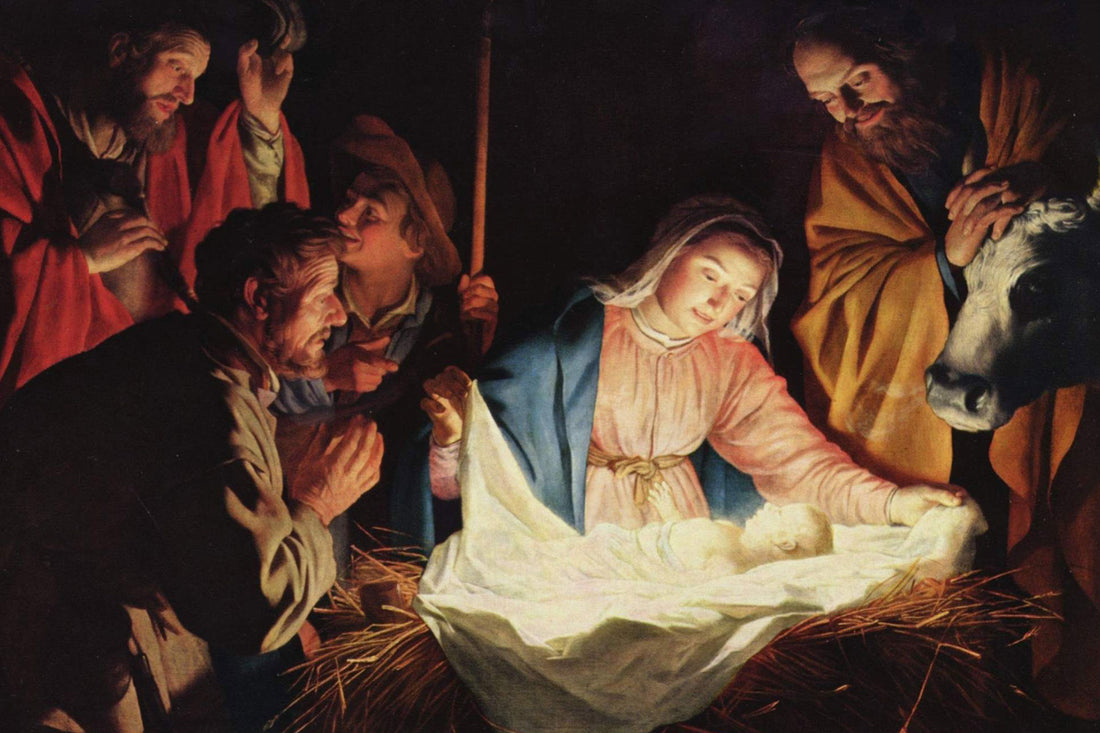Christmas honors the pivotal day which altered all of history. Christians around the world celebrate Christmas as the birthday of Christ Jesus. On this day, God Incarnate departed the hidden tabernacle of Mary’s womb into the blissful embrace of His mother’s arms. And she, in turn, presented this unblemished child, this Divine Gift, to all the world that we might adore Him as “Wonderful Counselor, Mighty God, Everlasting Father, Prince of Peace” (Isaiah 9:6).

As with any child’s arrival, there are many preparations to be made before welcoming the new family member; an expecting family gathers bathing items, blankets, and a collection of cozy outfits. Faithful members of the Catholic Christian family prepare for Christ’s coming by observing the season of Advent.
Advent is a time of joyful anticipation in which the faithful prepare their hearts for the most special arrival of the Divine Infant. Formally introduced by the Council of Tours in 567 AD, the Advent season begins four Sundays prior to Christmas Day. This period provides a precursor to the special holy day when the Light of the World shines amidst the darkness, the Sign of Hope dispels all despair.
One Catholic tradition orienting believers toward Christ’s coming is the Nativity Scene. This practice harkens back to Medieval times when in 1223, St. Francis of Assisi directed a live nativity scene as a form of public remembrance honoring Christ’s birth. St. Francis wanted to bring the Gospels to life, assigning parts for Mary, Joseph, the shepherds, and others so that in witnessing this reenactment, all people would learn the extraordinary story of God’s love for mankind. Often the nativity creche remains empty until Christmas Eve as a reminder that the faithful eagerly await the Christ child. And when the Divine Infant arrives, how much greater is the joy during the Christmas vigil when Baby Jesus joins the Holy Family and all humanity!
When the faithful prepare their hearts properly, the blessings of Christmas may be appreciated in full. “We Christians are called to safeguard and spread the joy of waiting,” Pope Francis declared in a Vatican address. Additionally, much as the faithful await Christ’s birth in remembrance of the first Christmas, the Catholic liturgical readings point the faithful toward awaiting Christ’s ultimate return upon Judgement Day.
According to Catholic tradition, the rejoicing of Christ’s coming lasts considerably longer than one great day. Rather, it stretches from the Christmas vigil Mass until the Feast of the Epiphany, sometimes called Three Kings’ Day.
Why did the Church choose to celebrate Christ’s birth on December 25? The most direct answer is that according to the Roman calendar, this day marked the winter solstice. Saint Augustine explained the significance of this day in remembering Christ’s coming, writing, “on the day which is the shortest in our earthly reckoning and from which subsequent days begin to increase in length. He, therefore, who bent low and lifted us up chose the shortest day, yet the one whence light begins to increase.”
The most excellent Catholic tradition of celebrating Christmas as a family is attending Holy Mass together. Even young adults who may have strayed from observing other tenets of their Catholic faith will often return to Mass with their families in order to observe the sacred Feast of the Nativity.
Christmas is a rare time when the Mass readings differ according to the order in which the Mass is offered. There are four distinct Christmas Masses. The Vigil Mass is offered at the start of Christmas Eve. The Mass of the angels is a popular celebration, offered at midnight. The Dawn Mass is called the Mass of the Shepherds; it is offered early morning. Finally, on Christmas Day, the priest offers the Mass of the Divine Word.
The Christmas octave is punctuated with a feast that originally honored Christ’s circumcision. In present times, the Catholic Church commemorates the first day of the year as the Feast of Mary, Mother of God. This holy day respects Mary’s unique human privilege of forming Christ physically and spiritually before releasing Him into the world to fulfill His divine salvific work.
The end of the Christmas season points toward this extraordinary mission for which God entered the world. According to Catholic tradition, the Magi, called the Three Kings, spent 12 days following a star. The brilliant star led them to Bethlehem, where Jesus had just been born. The Wise Men—Melchior, Caspar, and Balthazar—presented three symbolic gifts to the Holy Family for their newborn son. The kings presented to the Divine Child gold to honor His kingship, frankincense to honor His priesthood, and myrrh to honor His humanity.
Many families around the world present gifts to one another either in celebration of Christmas Day or in commemoration of the Three Kings. The faithful fulfill the Christmas spirit when offering their own hearts to the Divine Messiah who humbled Himself to enter the world as a small child.
Article written by Myriah C. Boudreaux for Christian Catholic Media
Myriah C. Boudreaux graduated from Franciscan University of Steubenville with a BA in Psychology. Soon after, she left her native Southern California home to marry a FUS alumnus, start a family, settle in Bayou Country with her Cajun husband, and begin a career homeschooling their ever-growing family. With seven children ranging from ages 21 – 2, her practical understanding of Heavenly Father's patience, love, and mercy is continually expanding.
Sources
Lisi, Clemente. “9 Catholic Traditions That Highlight the Christmas Season.” Religion Unplugged, Religion Unplugged, 3 Dec. 2018, religionunplugged.com/news/2018/11/27/9-catholic-traditions-to-celebrate-the-christmas-season.
“Roman Catholic Christmas Traditions.” Roman Catholic Christmas Traditions | Ritual Trip, ritualtrip.com/christmas/catholic-traditions.



